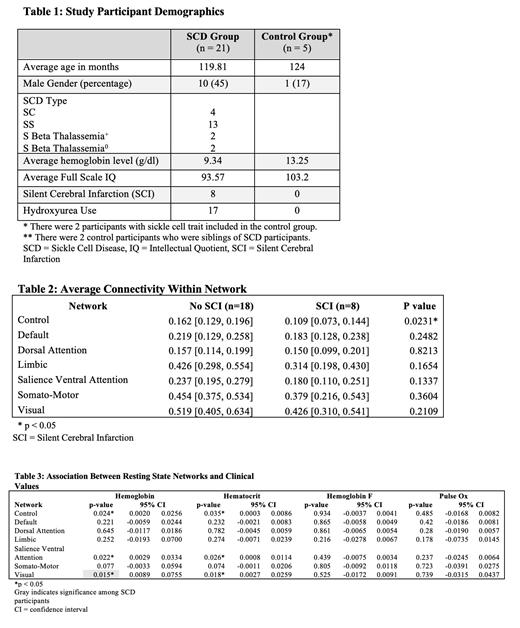Abstract
Children with sickle cell disease (SCD) have a high risk of developing cerebrovascular complications, such as stroke and silent cerebral infarction (SCI). SCI is associated with increased risk of future infarction as well as neurocognitive deficits related to brain injury location and size; however, neurocognitive impairment may occur in the absence of neuroimaging abnormalities. Resting state functional magnetic resonance imaging (RS-fMRI) measures blood oxygen level dependent (BOLD) signal during rest to evaluate functional connectivity between brain regions. Functional connectivity is the temporal correlation between the BOLD signal in spatially distant brain regions, which reflects synchronous activity. For this study, we hypothesized that participants with SCI would have lower functional connectivity than participants without SCI and that specific resting state networks would be associated with specific cognitive tests in SCD and control participants.
We recruited 26 participants from the local pediatric hematology and SCD clinics. Children with SCD were included in the study if they had a SCD diagnosis confirmed by laboratory studies and no known prior history of overt stroke or seizure. We obtained clinical history, laboratory tests, neuropsychological testing scores, and RS-fMRI scans in 21 participants with SCD and 5 control participants without SCD, 2 of who had sickle cell trait. Each participant received a resting state functional connectivity scan using a 3T MR scanner. Participants were asked to remain still, stay awake, and keep their eyes open during the resting state scan. The MRI study protocol included a BOLD scan and a T1-weighted magnetization-prepared rapid gradient-echo sequence (MPRAGE) with a scan duration of 8 minutes. We performed standard image pre-processing steps, including realignment, normalization to Montreal Neurologic Institute (MNI) standard brain space via MPRAGE image, spatial smoothing, and slice timing correction.
Table 1 shows the characteristics of the study participants. Eight participants with SCD had SCI diagnosed as an incidental finding during the study. The average connectivity within 7 resting state networks (control, default mode, dorsal attention, limbic, salience ventral attention, somato-motor, and visual networks) was compared between all (both SCD and control) participants with SCI and without SCI (Table 2). Participants with SCI had significantly lower functional connectivity in the control network (p = 0.0231, 95% CI: 0.073- 0.144) in comparison to participants without SCI. We also analyzed the relationship between 4 clinical variables and functional connectivity within each resting state network for all of the participants, with and without SCD. After adjusting for age and sex, there was a significant association between 3 resting state networks (control, salience ventral attention, and visual networks) and both hemoglobin and hematocrit (Table 3). There was a significant association between functional connectivity in the visual network and hemoglobin when adjusting for age and sex among just the participants with SCD (p = 0.045, 95% CI: 0.001-0.082). We analyzed the relationship between functional connectivity within each resting state network and neuropsychological test scores and found multiple significant associations between control, default mode, dorsal attention, salience ventral attention, and visual networks and attention/executive functioning test scores for all participants as well as just participants with SCD.
Our findings suggest that children with SCD and SCI have decreased functional connectivity in the control network in comparison to children with and without SCD without SCI, which may indicate abnormalities in brain regions underlying executive dysfunction. Our data also established a relationship between the degree of anemia and functional connectivity, showing increased functional connectivity in the control, salience ventral attention, and visual network in participants with higher hemoglobin and hematocrit levels. Neuropsychological data shows that select test scores are associated with changes in functional connectivity in resting state networks primarily involved with attention and executive functioning. This research supports the utility of RS-fMRI as an adjunct analysis for investigating neurocognitive abnormalities in pediatric SCD.
Lanzkron: Novartis: Research Funding; Imara: Research Funding; CSL Behring: Research Funding; Bluebird Bio: Consultancy; Shire: Research Funding; Novo Nordisk: Consultancy; Pfizer: Current holder of individual stocks in a privately-held company; Teva: Current holder of individual stocks in a privately-held company; GBT: Research Funding. Mirro: NOUS Imaging: Current Employment, Current holder of stock options in a privately-held company. Fields: Global Blood Therapeutics: Consultancy; Proclara Biosciences: Current equity holder in publicly-traded company. Lance: Novartis: Other: participated in research advisory board in 2020.


This feature is available to Subscribers Only
Sign In or Create an Account Close Modal